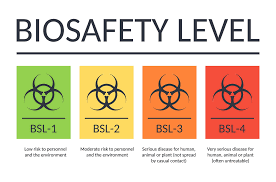Biosafety Levels:

Nehru Zoological Park, Hyderabad, will soon establish a Biosafety Level-3 (BSL-3) laboratory, the first of its kind in southern India, enabling rapid diagnosis, post-mortem analysis and research on zoonotic diseases.
- Biosafety levels (BSL), also known as biological safety levels or biohazard levels, define the necessary containment precautions for handling infectious agents in laboratory settings.
- They’re a mandatory requirement in any biological research facility.
- Biosafety levels contribute to the isolation of dangerous organisms and lethal agents.
- The levels of containment range from the lowest biosafety level 1 (BSL-1), to the highest at level 4 (BSL-4).
- Each BSL lab level builds upon the previous level—thereby creating layer upon layer of constraints and barriers.
- These lab levels are determined by the following:
- Risks related to containment
- Severity of infection
- Transmissibility
- Nature of the work conducted
- Origin of the microbe
- Agent in question
- Route of exposure
- BSL-1: It applies to laboratory settings in which personnel work with low-risk microbes that pose little to no threat of infection in healthy adults. Because of this, BSL-1 labs typically do not need to be isolated from surrounding facilities.
- BSL-2: It covers all laboratories that work with agents associated with human diseases — that is, pathogenic or infectious organisms — that pose a moderate health hazard if inhaled, ingested, or exposed to the skin.
- BSL-3: BSL-3 laboratory typically conducts research into or work on microbes that are either indigenous or exotic and can cause serious or potentially lethal disease through inhalation.
- BSL-4: BSL-4 labs are rare. As the highest level of biological safety, BSL-4 labs work with highly dangerous and exotic microbes. Infections caused by these types of microbes are often fatal and come without treatment or vaccines.




